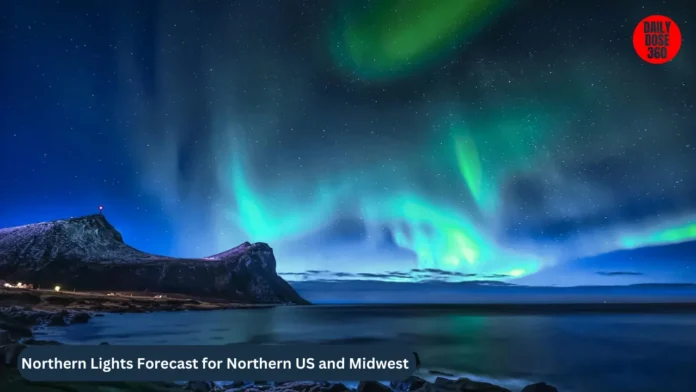Northern Lights Forecast in Northern US and Midwest this week update
Northern Lights Forecast : Thanks to certain developments in the solar activities of late, the northern part of the US and the Midwest are likely to experience sightings of the northern lights or aurora borealis as they are sometimes called. The stunning phenomena which are caused by geomagnetic storms and are only visible in rare cases, are however easier to catch in most parts of the year due to the high incidence of solar flares. Factors such as timings, geographical locations, and weather conditions that would guarantee the best view of the northern lights are covered in the rest of the article.
What Will Help in Seeing The Northern Lights this Week
The amazing light displays were caused by 2 CMEs that occurred just this week and were a follow-up to the solar flare which was the second most powerful in the current solar cycle. Data from NOAA’s SWPC indicate that these blast will produce geomagnetic storms making it just right for aurora borealis watching. Sparks of auroras have been clouded into the geomagnetic storm watches issued by Western part of the SWPC ranging from weak through the order through the order of moderate to strong predicting the visibility of sky lights over multiple parts of the northern states.
When and Where to See Aurora Borealis
As for the forecasts, the time frame for the auroras is expected to be from Octorber 3 and October 5, 2024, and the best time to view them would be on the October 4 Friday, that is from gebila midnight to early Saturday morning. As NOAA shows, forecasted locations will run as far south as Oregon and Pennsylvania, with most visible areas near the U.S.-Canada border.
Key states which are likely to experience auroras include:
- Alaksa
- Washington
- Montana
- North Dakota
- Minnesota
- Wisconsin
- Michigan
- Northern regions of New York and New England
If you want to increase your chances of witnessing the northern lights then find a place with little or no light pollution such as where it is rural or dark sky places.
What Causes the Northern Lights?
The lights are therefore produced as a result of sun emission charged particles coming into extremely energetic collisions with the gases present of the Earth’s atmosphere. The particles have some of Earth’s magnetic field released towards the poles and this leads to formation of the phenomena that is referred to as the aurora borealis. The eruption on the Sun, known as a solar flare, and the slow ejection of a coronal mass ejection (CME) also bring powerful energy to Earth in the process which further stimulate these phenomena and enhance the visibility of the lights.
Auroras can take on various colors depending on the type of gas particles involved:
- Green and yellow: oxygen at lower altitudes
- Red: oxygen at higher altitudes
- Blue and purple: nitrogen
Why Are Northern Lights Frequent Now Than Dreamt Of In A Year?
It is to be expected that with the oncoming maximum of the current 11-year solar cycle (Solar Cycle 25) there will be more frequent solar flares and CMEs. Therefore NASA predicts that sunspot activity which will be at a peak in 2025 will be quite as active increasing thus solar emissions and opportunities of seeing the northern lights within a few years.
And of course, these sunspots produce solar flares and CMEs, which, when intercepted by the magnetosphere of the Earth creates magnetic storms of a nature that can strengthen the phenomena of auroras.
How to Maximize Your Chance of Witnessing the Aurora Borealis
Despite such an encouraging prediction, actual experience of northern lights is relative and usually within expectancy level. Here are some tips to improve the probabilities:
- Choose a Dark Location: Seek rural areas that have little or no city lights.
- Check the Weather: Look at the weather reports for rain or fog that could conceal your area.
- Appropriately Time: The most usual hours to witness auroras usually fall between midnight (around 1am-2am).
- Be Patient: The looks of auroras can be abrasive and some may be almost invisible at the beginning. They have a high potential to wax over time and gradually subside.
Is it Possible to Watch the Northern Lights Without Special Viewing Equipment?
Yes, the northern lights are visible to the human eye but are best viewed under clear dark sky conditions. Their intensity can vary, from dim, low-lying horizon glares to brilliant, lively displays up high in the atmosphere. The aurora can be more vividly captured using long exposure photography.
What are the top spots for aurora borealis viewing?
If elation is what you’re looking for, and your craving is to see the northern lights more often than you should then this means you have to travel closer to the magnetic poles. The following are the primary regions for auroras:
- Alaska: One of the most popular and best states in the US where you get to see the northern lights every now and then.
- Iceland: A common spot for visitors heading on a northern lights holiday, when such chances are available from September to April.
- Scandinavia: Various viewing experiences can be had in Norway, Sweden and Finland that are inside the Arctic Circle.
By following this forecast, you might get a rare chance to experience the awe-inspiring beauty of the northern lights this week. Keep an eye on the NOAA’s aurora dashboard for updates and prepare for a memorable celestial display.
> Marvel’s Thunderbolts Trailer Reveals
> Jurassic World Rebirth (2025)

